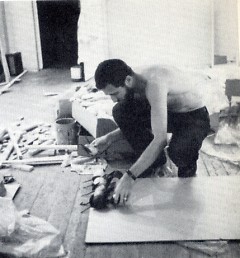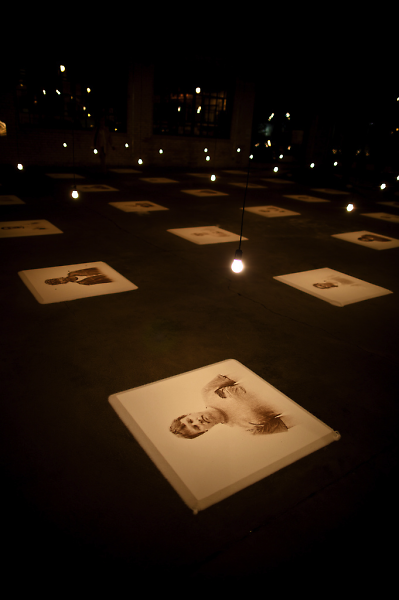Last September 27, I headed downtown with one question in my mind: “What will 100,000 paper airplanes look like?”
The event was Rob Bliss’s ArtPrize entry: paper planes dropped from the six tallest buildings downtown to the strains of Sigur Ros’s Olsen Olsen.
It was full of the surprises typical of any performance art including the audience’s involvement (20,000 people), anticipation, anticlimax, and entertainment. Bliss works in the tradition of Allan Kaprow, one of the fathers of performance art. Beginning in 1959, Kaprow staged “Happenings,” events that combined planned and unplanned elements that shifted from the artist’s control to the active participation of the viewers. Happenings often resulted in some amalgam of the audience’s puzzlement at the unpredictability and enjoyment of the experimentation.
Considering the audience’s size and evident appreciation, I was genuinely surprised when 100,000 Paper Airplanes and Melodies over Monroe wasn’t voted into the top ten. Taking an art historian’s longer view of matters, however, I surveyed where the final votes fell last year and identified a few specific criteria. Setting aside the obvious point of location, I observed that voters were drawn to the following characteristics:
- Technical skill but only with familiar media like paint, mosaic, Photoshop, metalwork, or balloon animals rather than unconventional materials like found objects, text and information, or space, time, and audience.
- A preference for representation and naturalism, especially photo-realism, over conceptual art.
- Playfulness.
While a work like 100,000 Paper Airplanes received a large one-time audience, the works considered to have the highest value (i.e.: deserving of a monetary prize) were images of something with recognizable subject matter and technique and were generally pleasing to the eye. Perhaps more pressing to me, however, was the debate over taste and authority that emerged in the aftermath.
The quality of the voting criteria (including location) was a source of frustration by some artists and art professionals (explosively voiced at the talkback panel near the end of ArtPrize). These tensions were highlighted in the last-minute Curator’s Choice award made by the Urban Institute for Contemporary Arts’ Visual Arts Committee (VAC) to Young Kim for the installation Salt and Earth. The $5,000 award was given anonymously by Young Kim’s admirers; Salt and Earth had been voted into the top 25, but fans felt that his location kept the work from being seen by as many people as the top ten winners.
There was another alternative award for sustainable art given by Cascade Engineering to Scott Hessels' Image Mill: Sustainable Cinema No. 1. The Sustainable Art Award differed from the Curator’s Choice Award, however, in that ArtPrize entries (224) were submitted ahead of time and then narrowed to five by a committee. From there, the winner was determined by a company-wide vote.
The Curator’s Choice award clearly contradicted one of the central claims of the competition: Awards would not be determined by a panel of experts informed by their training and art world experiences. That the VAC organized a Curator’s Choice award in response to a select audience’s disappointment over voting suggested that there was at least one art institution willing to override public opinion in order to redirect attention to a work deemed more worthy for its aesthetic value.
The tension between the institution and the public and their competing notions of artistic taste is reminiscent of ongoing debates about the role of public art. What is the function of art in the public sphere: To present a set of common values? To educate? To elevate public consciousness? How are values for art determined? Who gets to decide how the public should be educated, or in what ways the public’s consciousness of art should be elevated?
That such a discussion would arise in Grand Rapids is entirely appropriate, considering our significant public art legacy from La Grande Vitesse (the first public sculpture funded by the National Endowment for the Arts in 1967), to Sculpture Off the Pedestal, to Ecliptic, to ArtPrize. I found it regrettable, therefore, that those who were best equipped to lead the discussion (not the VAC or UICA solely; I include myself and my colleagues in higher education, and other arts institutions more generally) seemed to be more concerned with maintaining a set of oblique art world values and indicting the public for its poor taste than engaging a discussion as “radically open” as ArtPrize was intended to be.
ArtPrize is a potential site for public art education, but it requires active concessions on both sides. If you never have before, attend the Speakers Series at the Hub (the former Federal Building on Division). As with any election, self-directed education before voting leads to more informed voting and a greater investment in the outcome. Most of all, we all can benefit from asking ourselves whether we can be open to questions rather than answers from art.
On the other hand, I’m not sure that the conditions for a real discussion about art and public consciousness will be improved by the incorporation in this year’s ArtPrize of four juried awards, Best Two-Dimensional, Three-Dimensional, Time-Based Works and Best Use of Urban Space. The awards, $5,000 each, will be determined by four distinguished art world professionals.
Will these awards be perceived as the “real” awards because they will carry more art world caché, given the jurors’ reputations? Or will the smaller size of the juried prizes confirm that the “real” prize is still the largest one? I suspect that the answers to these questions will reaffirm some of last year’s presumptions. While some artists and art professionals may be appeased that a consideration of current trends in the art world will be taken into account in the awarding of media-based prizes, my concern is that the art world and the public will be further distanced from one another.
When this happens, does anyone win?
The Rapidian, a program of the 501(c)3 nonprofit Community Media Center, relies on the community’s support to help cover the cost of training reporters and publishing content.
We need your help.
If each of our readers and content creators who values this community platform help support its creation and maintenance, The Rapidian can continue to educate and facilitate a conversation around issues for years to come.
Please support The Rapidian and make a contribution today.




Comments
My hat goes off to The Rapidian for what, as far as I can tell, is the first real written discussion about important ArtPrize issues via your new ArtPrize Essay series. I tried myself last year to bring up ideas such as the ones you touch on by participating in the ArtPrize blog discussions and was banned.
Rick Devos calls his ArtPrize a " social experiment". As in any experiment there has to be a theory. I wonder what the theory of this one is?
Knowledge is a shared language. You learn and are then able to share with others in that language by growing in the amount of knowledge that you acquire on the subject. In this case art. Most people fully agree to the societal arrangement that you need to know what you are talking about before you can talk about something. We don't pretend to be a doctor or a banker or a local car mechanic. We don't have their knowledge and look to them for direction, answers or for them to share their knowledge with us. We all agree to this arrangement except, it seem, when it comes to art. And the mistake happens when taste becomes confused with the idea of knowledge. Taste is not knowledge. It's something different. Not less, not better. Different.
ArtPrize is a problematic event. It's theory, I believe, is to equate taste with knowledge. ArtPrize isn't just asking for you to engage with the art and the artists and voice your taste in what you like, it's giving you the power to make a decision on what is the best art in the bunch. That doesn't involve taste because in the ideal world of taste your taste is no more or less better than my taste. In the ArtPrize game you need to use knowledge to decide what in your mind is worthy of the top ten pieces in the competition for a very large prize of money.
In reality ArtPrize is a very big popularity contest. The most popular gets the prize. Popularity simply involves your taste. Something tells me ArtPrize wouldn't really like being labeled a big popularity contest. But it is.
This is the best article I have read on Artprize. I appreciate your insights and articulation of the chasm between the artworld and the public. Seeing how this years Top 10 is shaping up I think this article is more relevant than even a week ago. You basically called it.
I don't think it's necessarily an issue of education. It's an issue of effort as a viewer. You don't need to know the history or techniques of abstract art (for example) to appreciate it at some meaningful level- what you need is a willingness to be drawn in, to contemplate what it says to you or how it makes you feel.
There is a lot of spectacle in the competition, and it's easy to find entertainment and ignore pieces that require that effort. That's the hurdle, in my opinion. What I really lament are the people who look at a piece of art for two seconds, then move on to the next, and the next, as though they were surfing channels on television. The benches are meant for more than just sitting down when you're tired.
My hope is that the juried prizes will be awarded with a clear, educational explanation for the choice. If it's done in an unpretentious way, perhaps it will plant a seed for thinking about art in new ways.